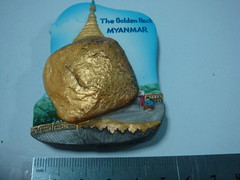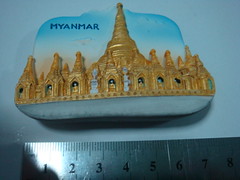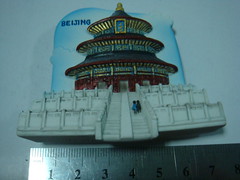
Kyaiktiyo Pagoda (Burmese: ; MLCTS: kyuik hti: yu:; also known as Golden Rock) is a famous Buddhist pilgrimage site in Mon State, Burma. A small pagoda (5.5 m (18 ft)) sits on top of a golden rock, a granite boulder covered with gold leaves pasted on by devotees. The rock itself is precariously perched and seems to defy gravity as it perpetually appears to be on the verge of rolling down the hill. The rock and pagoda are at the top of Mt. Kyaiktiyo, It is the third most important Buddhist pilgrimage site in Burma after the Shwedagon Pagoda and the Mahamuni Pagoda.
According to the legend associated with the pagoda, the Buddha, on one of his many visits to earth, gave a strand of his hair to Taik Tha, a hermit. The hermit, in turn, gave the strand to his adopted son King Tissa, an 11th Century Burmese king, with the dying wish that the hair be enshrined in a boulder shaped like the hermit's head. Tissa, with the help of the Thagymin, the king of the Nats found the perfect place for the pagoda at Kyaiktiyo where the strand was enshrined. It is this strand of hair that, according to the legend, prevents the rock from tumbling down the hill.
The village of Kinpun (16 km (10 mi)) at the base of Mt. Kyaiktiyo is the closest village to the pagoda. There are numerous other granite boulders on the mountain, some rocking and some not.
Kyaiktiyo has become a popular tourist attraction place of Pagodas in Burma.
The Golden Rock Of Myanmar as compared to Real View:

Shwedagon Pagoda, Myanmar
The Shwedagon Pagoda (IPA: [ʃwèdəgòun]; Burmese: ; MLCTS: hrwe ti. gum. bhu. ra, officially titled Shwedagon Zedi Daw, also known as the Golden Pagoda, is a 98-metre (approx. 321.5 feet) gilded stupa located in Yangon, Burma. The pagoda lies to the west of Kandawgyi Lake, on Singuttara Hill, thus dominating the skyline of the city. It is the most sacred Buddhist pagoda for the Burmese with relics of the past four Buddhas enshrined within, namely the staff of Kakusandha, the water filter of Konagamana, a piece of the robe of Kassapa and eight hairs of Gautama, the historical Buddha.
Real photo as compared to Fridge magnet:


Thailand - Land of Elephant

Thailand: The origin of Muay Thai

Pura Ulun Danu Bratan, Bali, Indonesia
Real Picture of Pura Ulun Danu Bratan

Located in Bedugul highlands,built in 1633 by the King of Mengwi,dedicated to Dewi Danu,the Goddess of the waters,the main building of the Temple lies on a small island of the Lake Bratan.As the lake is one of the major lakes which supplies water for the ricefields all over Bali,ceremonies and pilgrimages are held here to ensure that farmers in Bali have enough water and bountiful crops.
The Temple consists of several shrines on the grounds,along the shore but the most beautiful is the conventional Hindu thatched meru which seems floatting in the middle of the lake. On the mainland,Pura Teratai Bang(black lotus), featuring a seven thatched-roofed meru is dedicated to the God Brahma.
There are also a three roofed meru dedicated to Siwa and an eleven roofed one to Wisnu. Walking past the entrance are a large banyan,lovely gardens and a Buddhist shrine. Also on the site is a Mosque, opposite the Hindu Temple.

Temple of Heaven, Beijing, China

The temple complex was constructed from 1406 to 1420 during the reign of the Yongle Emperor, who was also responsible for the construction of the Forbidden City in Beijing. The complex was extended and renamed Temple of Heaven during the reign of the Jiajing Emperor in the 16th century. The Jiajing Emperor also built three other prominent temples in Beijing, the Temple of Sun in the east (日坛), the Temple of Earth in the north (地坛), and the Temple of Moon in the west (月坛). The Temple of Heaven was renovated in the 18th century under the Qianlong Emperor.
In 1914, Yuan Shih-kai, then President of the Republic of China, performed a Ming prayer ceremony at the temple, as part of an effort to have himself declared Emperor of China.
The Temple of Heaven was inscribed as a UNESCO World Heritage Site in 1998 and was described as "a masterpiece of architecture and landscape design which simply and graphically illustrates a cosmogony of great importance for the evolution of one of the world’s great civilizations..." as the "symbolic layout and design of the Temple of Heaven had a profound influence on architecture and planning in the Far East over many centuries."[1]
According to Xinhua, in early 2005, the Temple of Heaven underwent a 47 million yuan (5.9 million USD) restoration in preparation for the 2008 Beijing Summer Olympics and the restoration was completed on May 1st, 2006.
The Temple of Heaven is a very popular park for exercising, and particularly for practicing taiji bailong ball, which is a paddleball variation of Tai Chi.
4 comments:
wow. i never know that a fm would tell a lot of story. way to go! i just collect tequila shot glass. it doesn't tell much story as the fm.
hi, I would highly suggest when you use our pictures from the kyaiktyio pagoda and others at least tell where it comes from and make a link, otherwise it is STOLEN content !! the pictures come from
http://www.allmyanmar.com
yeah..i stole..so what??? don't blame me...blame google for putting it as public access....
hahhaa. funny. if they are afraid of ppl copying their rights, well, put watermark. put a BIGGER one, so that the whole world know that's coming from their website.
again. it's public access. :)
Post a Comment